Have you ever been to Lugo?
Friday, February 28, 2025
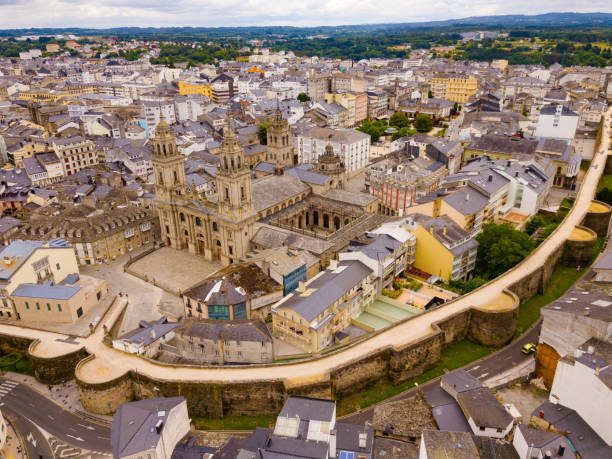
The walls of Lugo are an outstanding construction which illustrates various significant periods of human history. Starting with their Roman origins and passing through the problematical Middle Ages to the innovatory and disturbed 19th century, they unite in a single monumental construction over 2 km long different proofs and facets of the evolution of the town from the original Lucus Augusti.
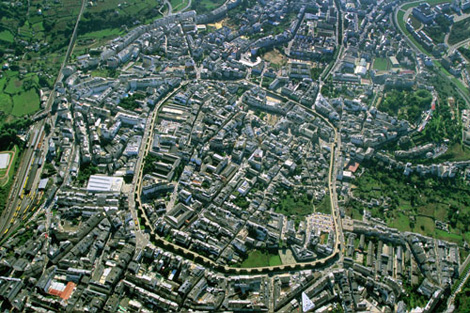
There was a Roman military camp here during the campaign of Augustus, and it was here that the new town, Lucus Augusti, was founded in 15-13 BCE. The original chequerboard plan did not require the town to be enclosed by a defensive wall, because of the effectiveness of the Pax Romana. The town prospered in the succeeding centuries, because of the mineral resources of the region. This administrative centre acquired impressive public buildings and luxurious urban villas, which spread over a wide area.
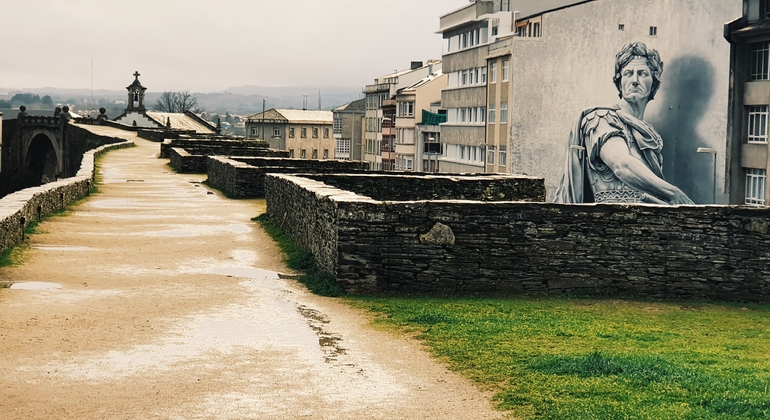
However, in the mid-2nd century Frankish and Alemannic invaders crossed the limes and ravaged Gaul, penetrating into Hispania before being driven out. This resulted in the construction of massive urban defences at all the towns of the western Roman provinces. Lucus received its walls between 263 and 276 (perhaps less against barbarian invaders from across the Rhine than against the local tribesmen, who had never fully accepted the Roman occupation of their lands). As in most colonial towns, the area enclosed by the walls was less than that of the urban settlement: a considerable part of the town in the south-east remained outside. Despite the strength of its fortifications, Lugo was unable to resist the Suevi when they swept into the peninsula in the early 5th century and destroyed the town by fire. They were to be dislodged in their turn by the Visigoths, who captured the town in 457 and settled it once again. The irresistible Moorish invasion of Spain saw Lugo overwhelmed and sacked in 714, but it was recaptured for Christendom by Alfonso I of Asturias in 755 and restored by Bishop Odarius. The town was to be ravaged once again in 968 by the Normans, on their way to the Mediterranean, and it was not restored until the following century.
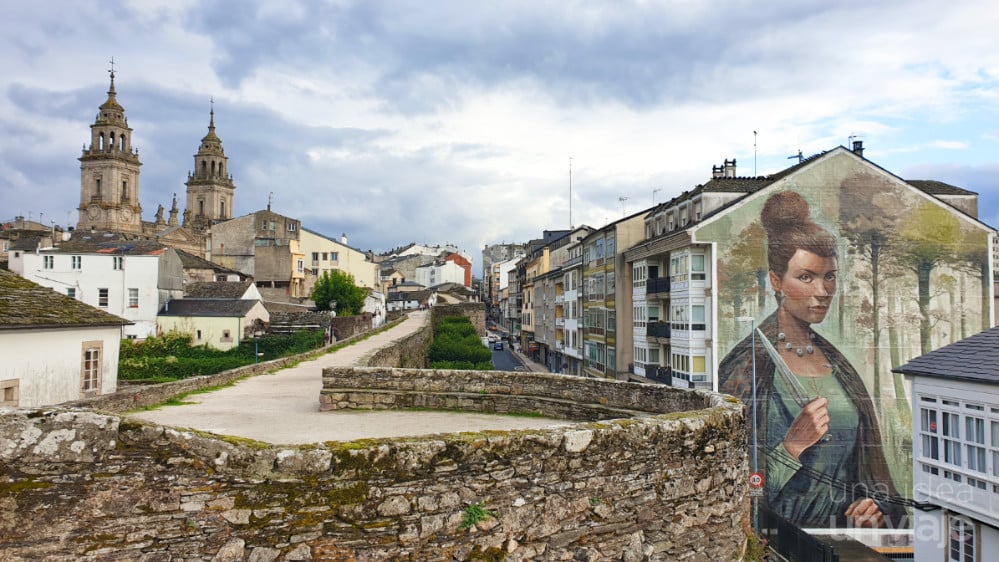
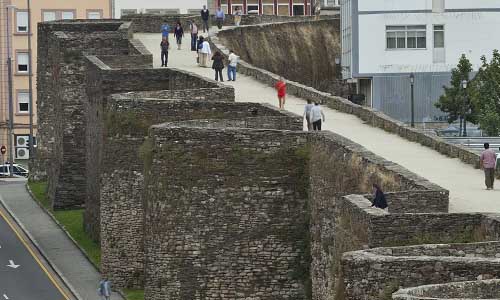
The structure of the Roman walls of Lugo consists of internal and external stone facings with a core filling of earth, stones and pieces of worked Roman stone from demolished buildings. There are ten gates: five ancient and five recent. Five stairways and a ramp give access to the parapet walk. A number of double staircases giving access from the parapet walk to the towers have been found within the thickness of the walls, and it is assumed that each of the towers was provided with similar stairways. Of the original interval towers, 46 have survived intact, and there are a further 39 that are wholly or partly dismantled. They are spaced at irregular intervals round the walls; they were two-storeyed and most of them are roughly semi-circular in plan, the gap in the wall in which they were constructed varying in width from 5.35 m to 12.80 m.
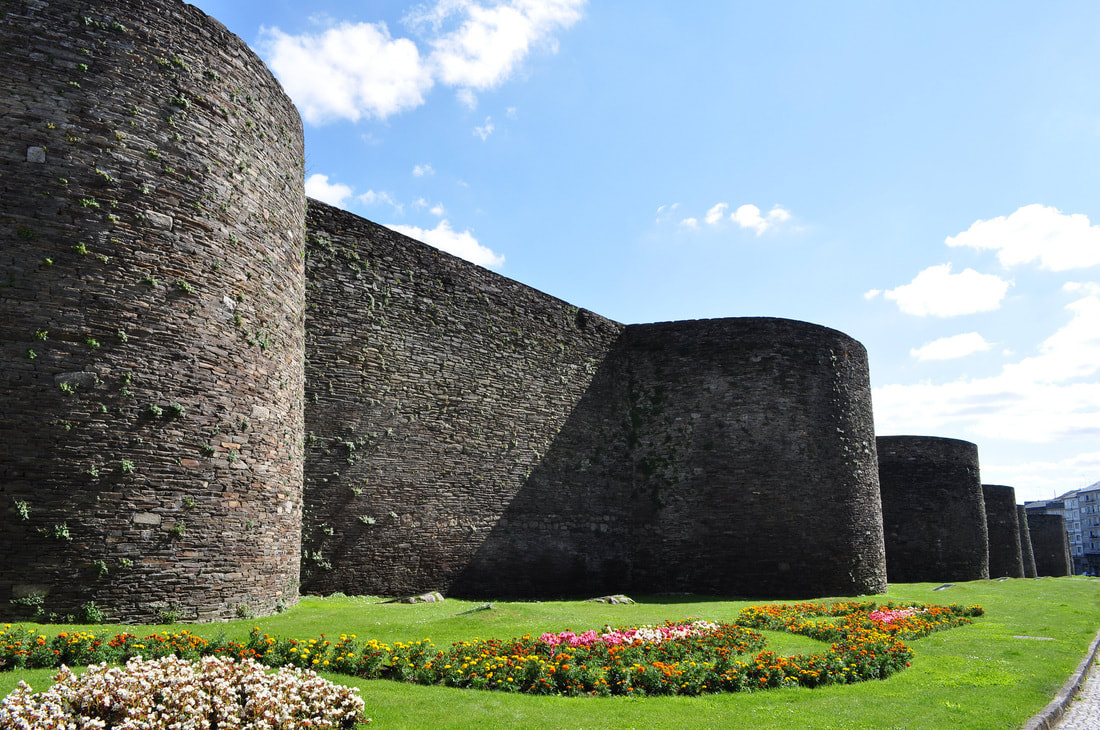
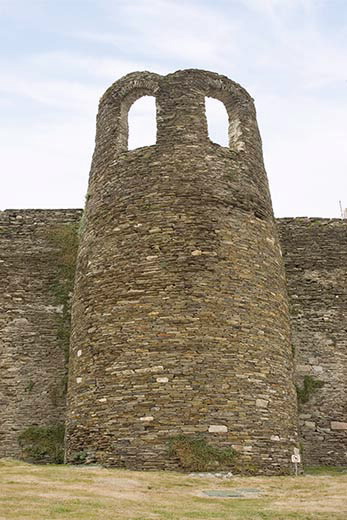 Several take the form of slightly tapering truncated cones, and a few have rectangular plans. One of the towers, known as La Moschera, is surmounted by the remains of its superstructure containing two arched windows. There is a variety of materials to be observed in their construction, and in that of the walls themselves. The main stones used were dressed granite and, in particular, slate. There is some variety in the forms of laying the stones and in their size. In some cases the slate walls rise from foundation courses of granite; in other examples these basal courses are also in slate. Yet another common wall make-up consists of the courses in the lower half or two-thirds being of dressed granite with the remainder in slate, but with some granite blocks interspersed. The parapet is crenellated in places, but this is certainly post-Roman work. Considerable reconstruction work took place at what is now known as the Reducto de Santa Cristina in 1836- 37, to create a fort that accorded with the military architecture of the period. Several take the form of slightly tapering truncated cones, and a few have rectangular plans. One of the towers, known as La Moschera, is surmounted by the remains of its superstructure containing two arched windows. There is a variety of materials to be observed in their construction, and in that of the walls themselves. The main stones used were dressed granite and, in particular, slate. There is some variety in the forms of laying the stones and in their size. In some cases the slate walls rise from foundation courses of granite; in other examples these basal courses are also in slate. Yet another common wall make-up consists of the courses in the lower half or two-thirds being of dressed granite with the remainder in slate, but with some granite blocks interspersed. The parapet is crenellated in places, but this is certainly post-Roman work. Considerable reconstruction work took place at what is now known as the Reducto de Santa Cristina in 1836- 37, to create a fort that accorded with the military architecture of the period.
The original gates have undergone a number of transformations since the 3rd century. The best preserved are the Falsa Gate and the Miñá Gate, which still has its original vaulted arch set between two towers, in characteristic Roman form; traces of the now disappeared guard chamber can be seen on the interior wall (also visible at the San Pedro Gate).
A walkway over the walls now allows visitors to stroll along the entire length. The town also has a visitor's centre dedicated to the walls, the Centro de Interpretación de la Muralla. Since the inscription of the walls on the World Heritage List in 2000, Lugo holds a popular festival called Arde Lucus each year to celebrate its Roman past.
Ver mapa más grande
 1
Like
Published at 8:48 AM Comments (1)
1
Like
Published at 8:48 AM Comments (1)
A Journey Through Time at the Rio Tinto Park
Thursday, February 20, 2025
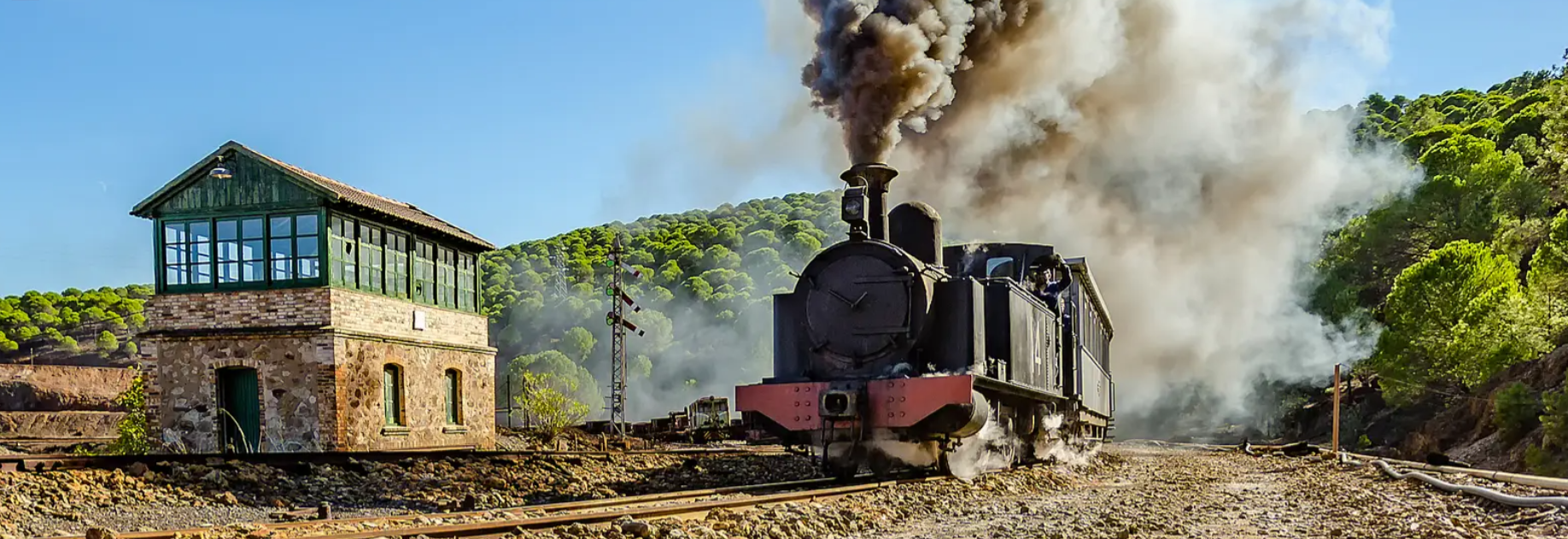
Nestled in the heart of Spain's Huelva province, the Rio Tinto Mining Park stands as an evocative testament to the region's rich mining history. Central to this historical mosaic is the tourist train ride, a heritage railway that offers visitors a unique opportunity to traverse the scenic landscapes and delve into the mining lore that has shaped the area for centuries.
The Rio Tinto Mining Park, a sprawling 4,500-hectare facility, serves as an open-air museum, preserving the legacy of more than 5,000 years of mining activity. Among its myriad attractions, the tourist railway is arguably the most compelling. This century-old railway stretches for 12 kilometres and provides an immersive experience that marries the romance of vintage rail travel with the gritty allure of industrial history.
The Railway's Genesis: From Commercial Lifeline to Tourist Attraction
The origins of the tourist railway are closely intertwined with the development of the Rio Tinto mines. In the late 19th century, the British-owned Rio Tinto Company Limited engineered a network of railways to facilitate the transport of copper ore from the mines to Huelva's port. These railways were vital commercial arteries, ensuring the steady flow of minerals and processing materials.
By the early 21st century, as the mining industry in Rio Tinto dwindled, a concerted effort to preserve and repurpose the railway began. Through the meticulous restoration, the railway was transformed into a tourist railway, offering a fresh lease of life to these storied tracks.
Embarking on a journey aboard the Ferrocarril Turístico Minero is akin to stepping back in time. Visitors board vintage carriages, carefully restored to their former glory. The rhythmic clatter of wheels on rails, the swaying journey, and the occasional whistle transport passengers to a bygone era.
Departing from the historic station at Minas de Rio Tinto, the train meanders through terrains that narrate tales of geological wonder and human endeavour. Copper-coloured earth, reminiscent of Mars’ surface, provides a striking contrast against the greenery that dots the landscape sporadically. As the train chugs along, passengers are treated to panoramic views of the Rio Tinto River’s ochre-hued waters, bearing witness to the natural and industrial forces that have sculpted this extraordinary landscape.
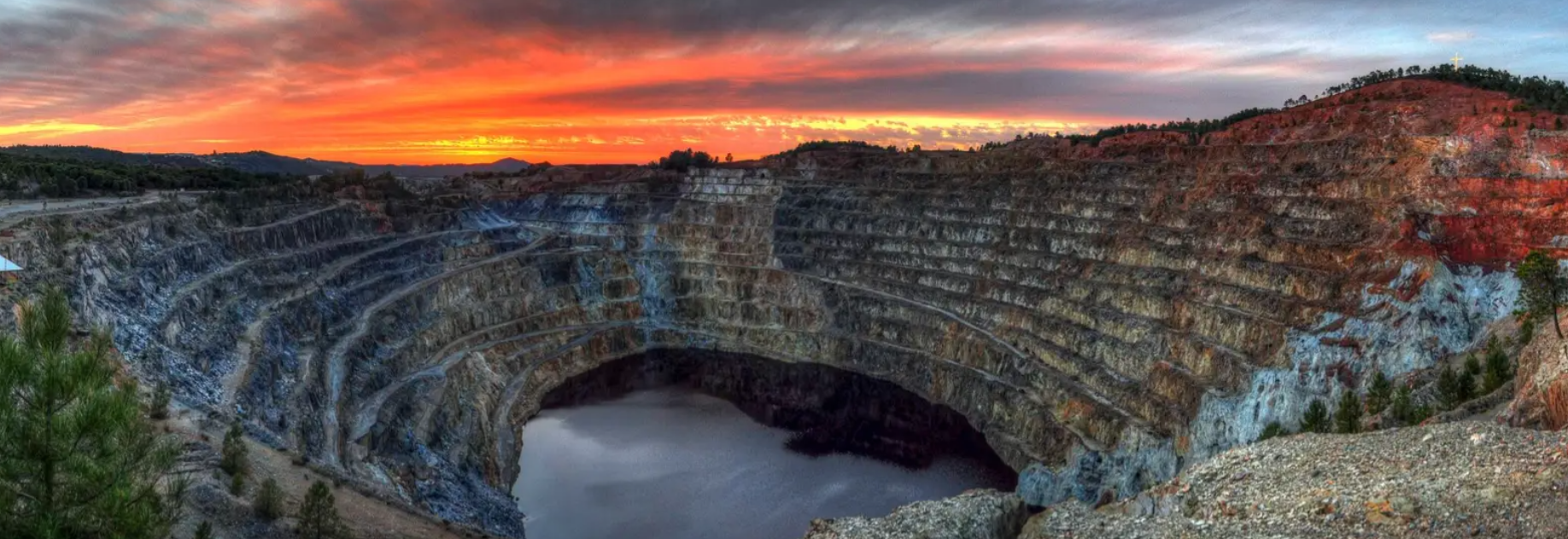
Highlights Along the Route
The railway route is punctuated with noteworthy landmarks that enrich the journey:
-
Corta Atalaya: Once Europe's largest open-pit mine, Corta Atalaya’s vast, terraced expanse offers visitors a staggering perspective on the scale of mining operations. Although no longer active, its sheer size and the scars left upon the landscape evoke a profound sense of industrial achievement.
-
Ernest Lluch Powerplant: Named after the Spanish economist and politician, this decommissioned powerplant stands as a sombre relic of the industrial age, juxtaposed against the tranquillity of the surrounding scenery.
-
Berrocal Alto Mine: A testament to ancient mining practices, Berrocal Alto Mine's ruins illustrate the evolution of extraction techniques through the ages.
Bridging Past and Present
The railway serves not only as a conduit to the past but also as a bridge to the present. Modern interpretative centres along the route provide context and commentary, ensuring visitors appreciate both the historical significance and present-day relevance of the region's mining heritage. The narrative extends beyond industrial exploits to encompass the archaeological and ecological facets of the region, with emphasis on ongoing efforts to rehabilitate and repurpose former mining areas.
The park encapsulates a broader educational mission, using the railway as a didactic tool. Educational programmes tailored for school groups and academic researchers help disseminate knowledge about geology, engineering, and environmental science. Additionally, the railway occasionally hosts cultural events, including historical reenactments and themed excursions, enriching the visitor experience and fostering an appreciation for the region's cultural history.
Visitor Information
The railway operates various routes with differing durations, accommodating both leisurely tours and more in-depth explorations. Ticketing information, operating schedules, and special event announcements are accessible via the "Parque Minero de Rio Tinto’s" official website.
Tips for a Memorable Visit
-
Advance Booking: Given the popularity of the railway, especially during weekends and holidays, it’s prudent to book tickets in advance.
-
Dress Appropriately: The journey entails both indoor and outdoor experiences. Comfortable clothing and sturdy footwear are recommended.
-
Engage with Guides: Knowledgeable guides accompany many tours, offering insights and anecdotes that enrich the journey.
The Rio Tinto Mining Park is more than just a railway; it is a living museum that encapsulates the spirit of an industrious past while embracing the potential of the future. This journey through time offers a poignant reminder of the ingenuity and resilience that underpin humanity’s progress, making it a must-visit for history enthusiasts, industrial heritage aficionados, and curious travellers alike.
 3
Like
Published at 10:17 AM Comments (0)
3
Like
Published at 10:17 AM Comments (0)
One Town - Two Time Zones
Friday, February 14, 2025
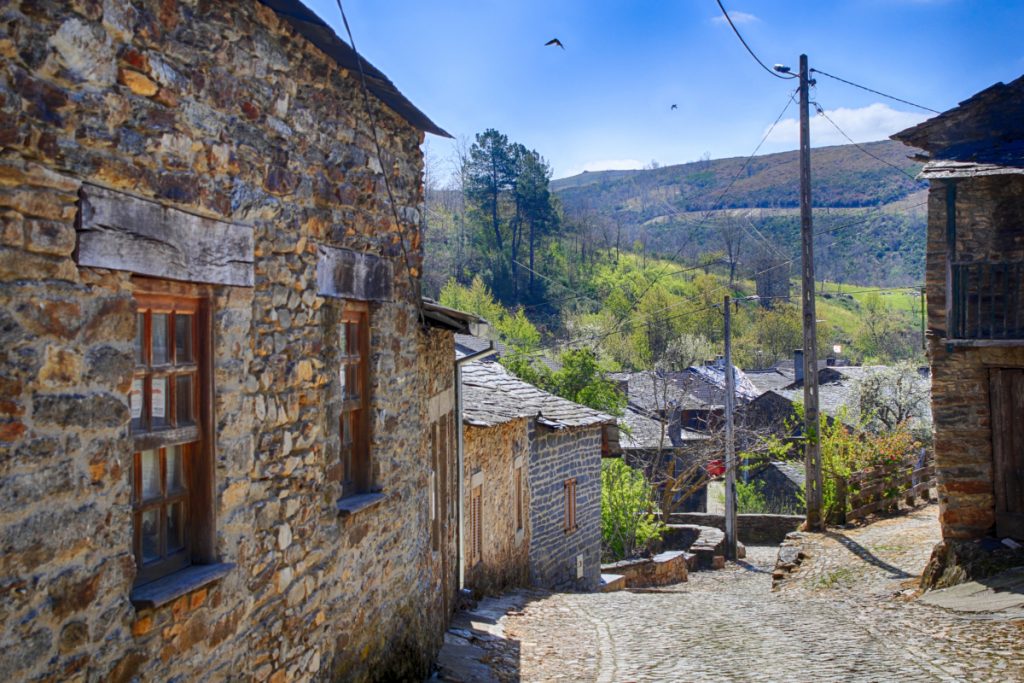
Rihonor de Castilla is a town in Castilla y León with just over 100 inhabitants. Despite its small size, it can boast of being the only town in Spain with two time zones. How is it possible? Because, in reality, it belongs to two countries, Spain and Portugal. Rihonor de Castilla is a town where bilingualism is common since the residents speak both Spanish and Portuguese. The inhabitants also share a unique language, Rihonorés, a dialect derived from Leonese.
It is a very peculiar municipality. Rihonor de Castilla, which belongs to the Zamorano municipality of Pedralba de la Pradería (Zamora) forms a unit with the Portuguese town of Río Onor. Both towns are one, divided by an imaginary line.
Because part of the urban area belongs to Spain and part to Portugal, bilingualism is common among its little more than 100 inhabitants -some 75 Portuguese and just over 30 in the Spanish.
The inhabitants of Rihonor de Castilla refer to the part of Zamora as Pueblo de Arriva or Povo de Xima and to the part of Portugal as Pueblo de Abajo or Povo de Abaixo.
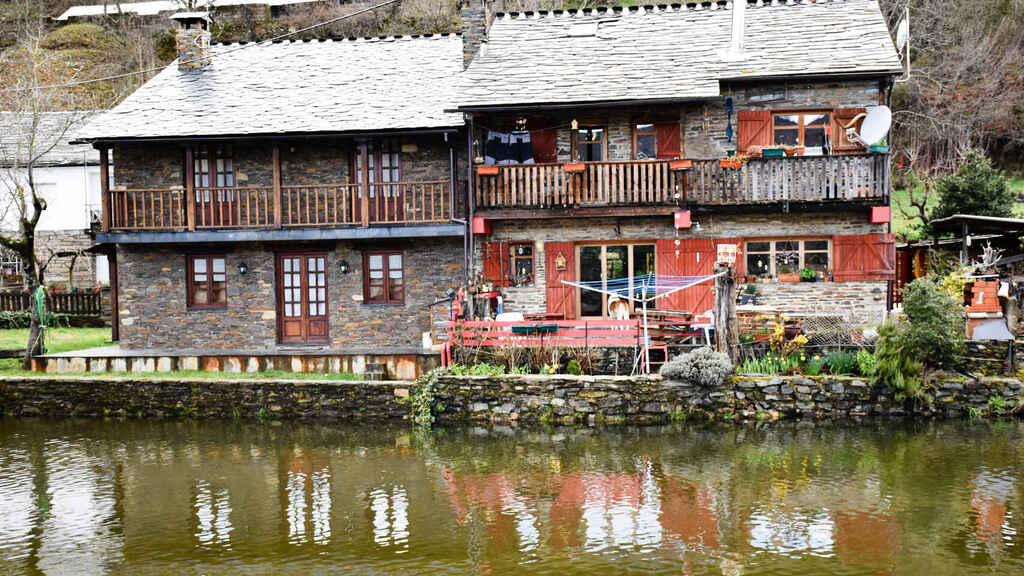
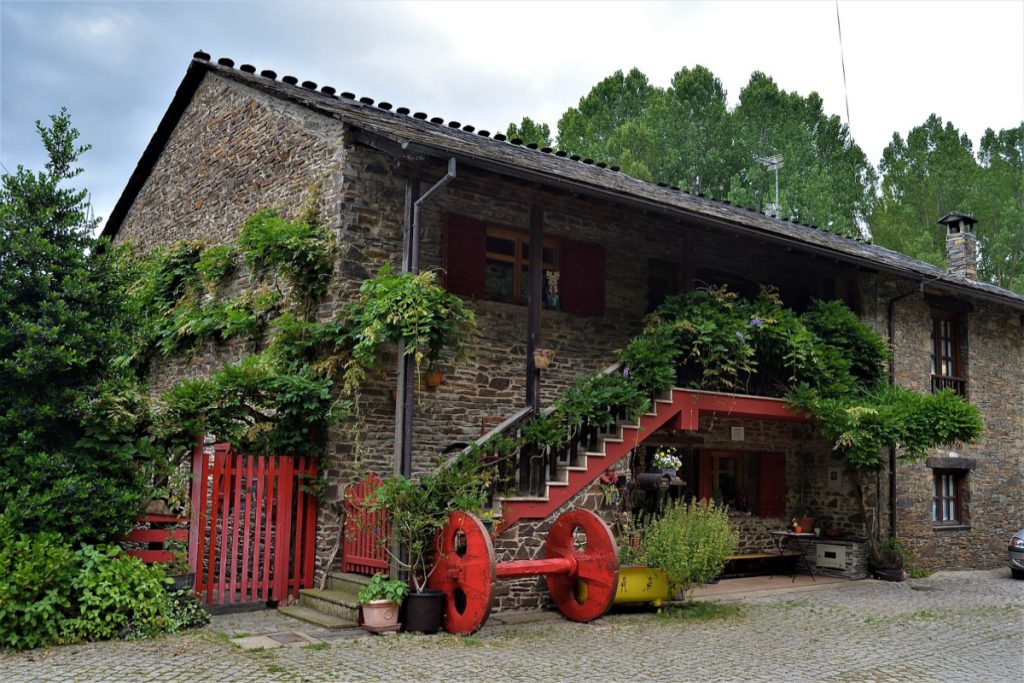
In the Modern Age, the town was integrated into the province of the Lands of the Count of Benavente. In 1833 the provinces as we know them today were restructured, and Rihonor de Castilla, still an independent municipality, became part of the province of Zamora.
In 1850 it was integrated into the term of Pedralba de la Pradería, where it remains to this day. Pedralba de la Pradería is a town located in the Sanabria region with a population of 200 inhabitants.
The main attraction of the only town in Spain with two time zones is the popular architecture. The houses maintain the architecture of yesteryear, with stone walls, slate roofs and wooden balconies.
Life in this small town is very quiet, and the residents only have to worry about adjusting the clock on both sides of the border, since in Portugal it is one hour less than in Spain.
 1
Like
Published at 8:37 PM Comments (0)
1
Like
Published at 8:37 PM Comments (0)
Unveiling Spain's Rudest and Most Courteous Cities
Friday, February 7, 2025

In today's interconnected and culturally diverse world, social etiquette plays a pivotal role in defining the character of a city. Understanding whether a city's inhabitants are generally polite or discourteous can influence tourism, business, and interpersonal relationships. A recent study conducted by Preply, a language learning platform, sheds light on the rudest and most courteous cities across Spain. This comprehensive analysis, published in April 2024, delves into the social behaviours that shape these perceptions across 19 significant Spanish cities. Whether you're a traveller, a foreign resident, or a local, understanding these dynamics can enhance your experience within Spain.
The Rudest Cities in Spain as Revealed by Preply
The findings of Preply's study identify several cities in Spain where residents may come off as ill-mannered to outsiders. Of these, Santa Cruz de Tenerife emerges as the city topping the list, with a score of 6.06 out of 10 for rudeness. This perception, as explained by the report, is driven by several behavioural tendencies, including an excessive amount of time spent on mobile phones and a lack of consideration in traffic situations, such as not yielding to other vehicles.
Granada follows with a score of 5.95, described by the study as a place where locals may occasionally exhibit a bad temper. Another city highlighted for its brash reputation is the coastal conurbation of Alicante-Elche, scoring 5.81, which surpassed the national average rudeness score of 5.53.
Further cities featuring in this less-than-flattering section of the report include San Sebastián (5.77), Bilbao (5.73), and Palma (5.69), with Barcelona and Málaga following closely with 5.64 and 5.61, respectively.
Here is a summary of some of the rudest cities as per the study:
- Santa Cruz de Tenerife - 6.06
- Granada - 5.95
- Alicante-Elche - 5.81
- San Sebastián - 5.77
- Bilbao - 5.73
The Most Courteous Cities in Spain
While some cities rank high on the rudeness scale, the study also celebrates the most polite and courteous locales. Topping this list is Vigo, scoring 5.17, marking it as Spain's politest city according to the survey.
Following Vigo, the A Coruña-Oleiros-Arteixo conurbation takes second place, showing that Galicia, as a region, boasts areas noted for their resident's considerate behaviour. Valencia and the Murcia-Orihuela area shoulder past participants, securing third and fourth place for politeness.
Evaluating Behaviour: What Makes a City Rude?
When assessing the rudeness of a city, the study took into account various day-to-day behaviours, which reflect residents' levels of courtesy and education. Among the widespread behaviours scrutinised, habitual mobile phone usage in public spaces emerged as a chief complaint, with San Sebastián reportedly leading in this respect.
Additionally, failing to acknowledge or greet strangers and viewing videos loudly in communal areas also contribute to the perception of impolite conduct.
Beyond public behaviour, the study includes driving etiquette, noting behaviours such as failing to concede way in traffic or not slowing down in pedestrian zones. Disrespect towards personal space further complicates these negative perceptions.
Such behaviours, though they may appear trivial on the surface, cumulatively feed into broader societal impressions that ultimately define the amiability of a city.
The Tipping Culture in Spanish Cities
Tipping etiquette traditionally varies across cultures, and within Spain, the study highlights disparities in how freely tips are given across different cities. Santa Cruz de Tenerife, already positioned as the rudest city, reportedly has the lowest tipping percentage at 6.10%.
Other cities exhibiting less generous tipping habits include San Sebastián and the Murcia-Orihuela area, with percentages of 6.16% and 6.49%, respectively.
On the contrary, residents of Valladolid appear to be the most generous tippers, with an average tipping rate of 10.18%. Las Palmas de Gran Canaria and the A Coruña-Oleiros-Arteixo area follow in generosity.
The results of this study provide insightful data for both locals and travellers. For local government and city planners, understanding these perceptions can inform strategies to improve local etiquette through civic education and training. For businesses, especially those in the hospitality industry, this data offers an opportunity to tailor customer service practices to mitigate perceived rudeness and enhance visitor experience.
On a personal level, these insights encourage both locals and visitors to reflect on their own social behaviours and the impact these may have on community harmony. By fostering a culture of politeness and consideration, cities can enhance their reputation, attracting more tourists and creating a welcoming environment for new residents.
The study by Preply serves as a reminder of the importance of courteous behaviour in shaping the perception and experience of a city. Whether in the bustling streets of Madrid or the tranquil corners of Galicia, being considerate, respectful, and genuine can make a significant difference.
As the global community grows more interconnected, promoting understanding and polite interaction within different cultural contexts becomes increasingly essential. Regardless of the rankings, every city in Spain offers its unique charm and appeal, and Spain continues to be a welcoming destination—where respect and kindness cultivate a positive atmosphere for everyone to enjoy.
 4
Like
Published at 9:54 PM Comments (0)
4
Like
Published at 9:54 PM Comments (0)
The Knights Templar in Spain: Following the Trail of a Secret Order
Thursday, February 6, 2025
Spain, a land steeped in history and legend, holds within its borders the remnants of a powerful and enigmatic order: the Knights Templar. These warrior monks, sworn to protect pilgrims and fight in the Crusades, left an indelible mark on the Iberian Peninsula, a legacy that endures to this day in the form of imposing castles, serene churches, and whispers of secret rituals.
Rise of the Order in Spain
The Knights Templar arrived in Spain during the Reconquista, the centuries-long struggle to reclaim the peninsula from Moorish rule. Their military prowess and organizational skills made them invaluable allies to the Christian kingdoms. Kings granted them lands and privileges, allowing them to establish a network of commanderies – fortified settlements that served as bases for their operations.
Key Templar Sites
- Castle of Ponferrada (Castilla y León): This imposing fortress, perched on a hill overlooking the town of Ponferrada, was a key Templar stronghold. Explore its towers, ramparts, and keep, imagining the knights who once walked its halls.
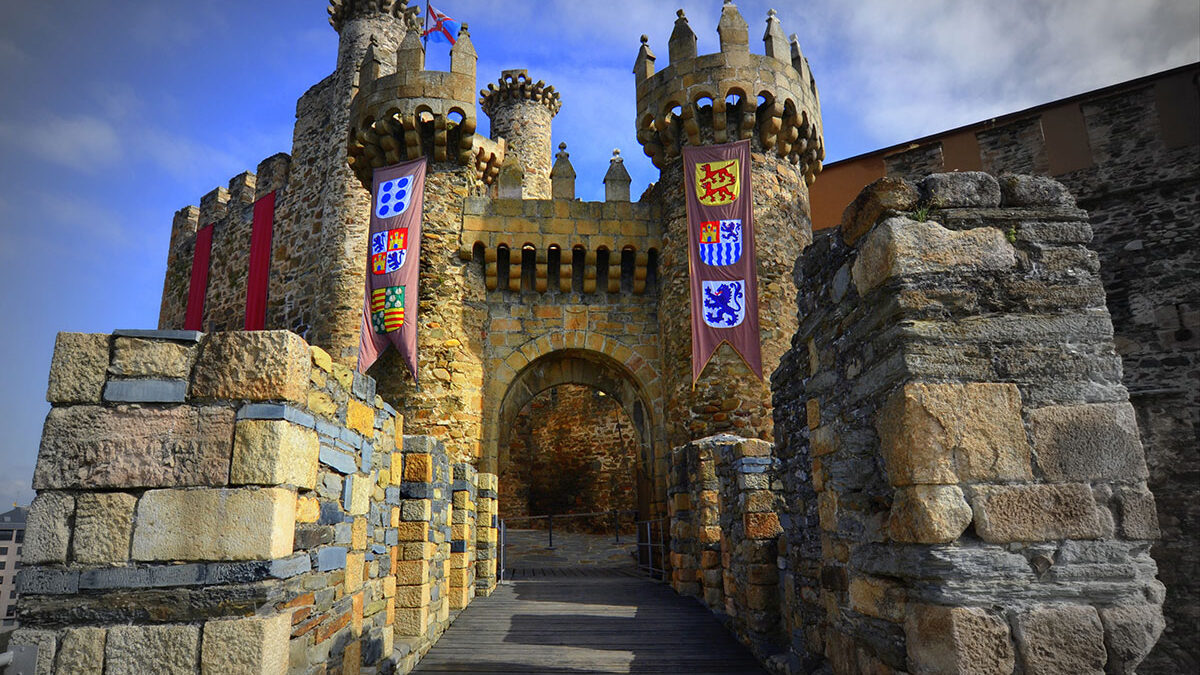
- Monastery of San Juan de Duero (Soria): This Romanesque monastery boasts a unique cloister featuring intricate interlaced arches, a testament to the Templars' architectural influence.
- Church of Vera Cruz (Segovia): This 13th-century church, with its distinctive dodecagonal shape, is believed to have been modelled after the Church of the Holy Sepulchre in Jerusalem.
- Castle of Peñíscola (Valencia): Perched dramatically on a rocky headland, this castle served as a Templar refuge and later as the papal seat of Benedict XIII during the Western Schism.
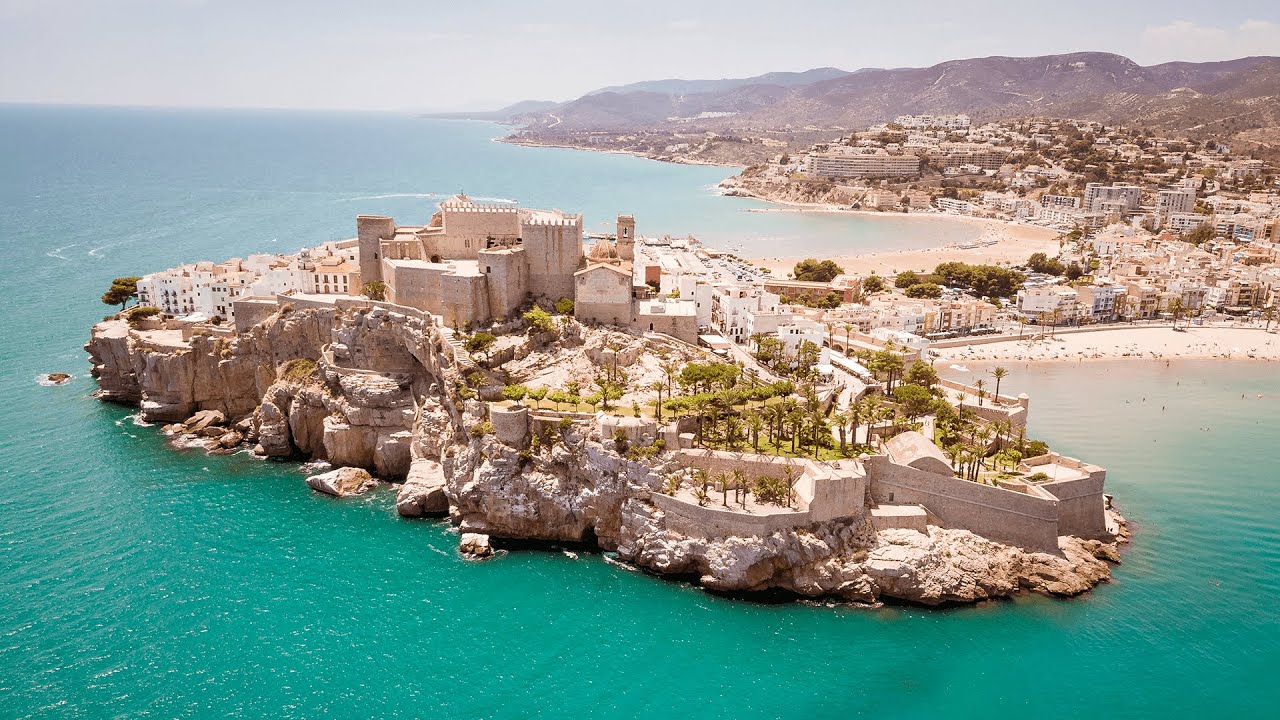
Beyond the Stones: Legends and Mysteries
The Templars were shrouded in secrecy, fueling speculation and legend. Some believe they possess hidden knowledge and vast treasures, while others associate them with mystical practices. While separating fact from fiction can be challenging, these mysteries add to the allure of exploring their history in Spain.
A Journey Through Time
Following the trail of the Knights Templar in Spain is a journey through time, a chance to connect with a fascinating chapter in history. Whether you're exploring a majestic castle or deciphering cryptic symbols in an ancient church, the spirit of these warrior monks continues to resonate across the Spanish landscape. So, embark on your own quest and uncover the secrets of the Knights Templar in Spain.
 3
Like
Published at 1:32 PM Comments (0)
3
Like
Published at 1:32 PM Comments (0)
The Museum of Anatomy - A Mummified Collection
Saturday, February 1, 2025
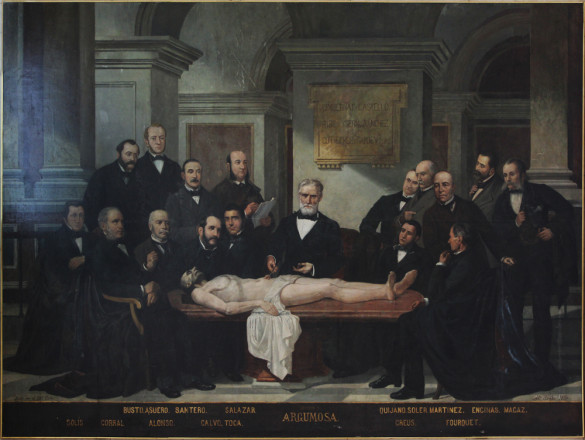
An incredible collection of anatomical models, mummified body parts, and human bones can be discovered in one of the world's oldest universities.
The Universidad Complutense of Madrid is one of the oldest universities in the world. Its story begins as far back as 1293 when the Archbishop of Toledo was granted a charter by King Sancho IV of Castile to found a “studium generale.” Two hundred years later, in 1499, Pope Alexander VI granted a papal bull, which expanded the Complutense into a full university.
Today, the best reason to visit the University is its Museum of Anatomy, “Javier Puerta,” created in 1787 by royal decree of King Charles III, who was known for his contributions to science and research.
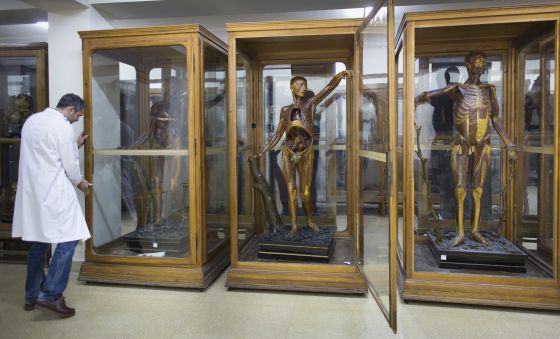
Part of the college of medicine, the museum is made up of anatomical models, mummified and artificial body parts, and three sculpture collections. The wax polychrome sculpture collection displays a series of anatomically precise wax models, representing the stages of pregnancy from conception to childbirth, the oldest of which dates back to 1794. The plaster polychrome sculpture collection is essentially a collection of plaster sculptures of human body parts. The ominous-sounding bone collection is comprised of thousands of skulls and two skeletons.
One of these, which dates back to the Spanish War of Independence (1807-1814), is the skeleton of a French farmer and grenadier who, due to the mercury salts in his bones, is speculated to have been killed by mercury poisoning. The other is the skeleton of the so-called Extremeño Giant, said to have been brought to the museum alive by Pedro Gonzalez de Velasco, the museum’s director at the time.
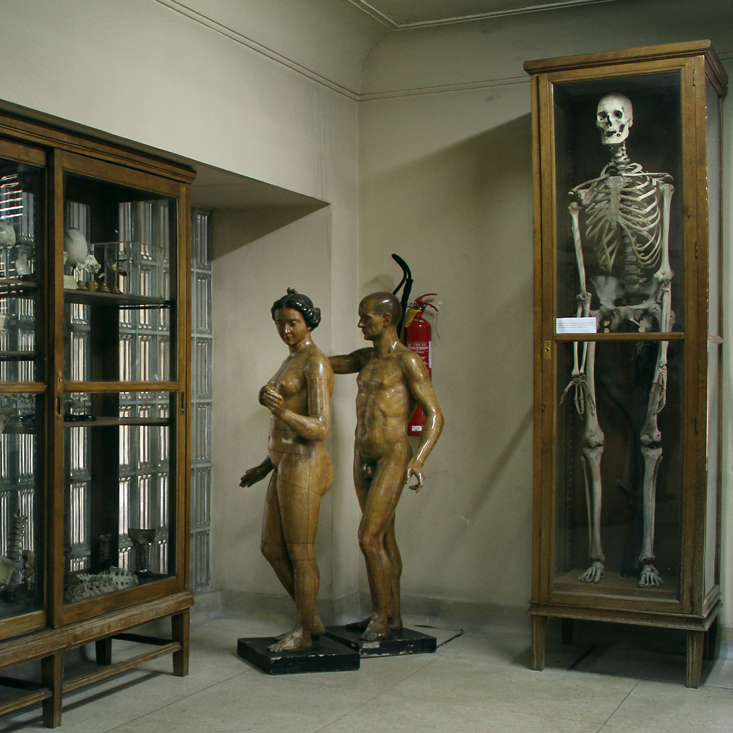
To be sure that the museum is open at the time you'd like to visit, give them a call at +34 913 94 13 74, or request an appointment by email at fviejo@med.ucm.es.
 0
Like
Published at 1:01 AM Comments (0)
0
Like
Published at 1:01 AM Comments (0)
Spam post or Abuse? Please let us know
|
|